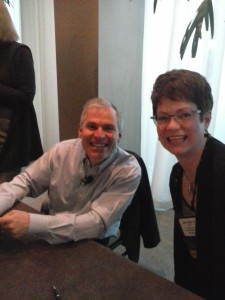 Confession time: I’ve always been sort of “meh” about business fables as a literary device. So it may seem strange to you that there is a photo of me with New York Times best-selling author Patrick Lencioni (arguably the most successful author writing in this genre) here on my blog.
Confession time: I’ve always been sort of “meh” about business fables as a literary device. So it may seem strange to you that there is a photo of me with New York Times best-selling author Patrick Lencioni (arguably the most successful author writing in this genre) here on my blog.
Pat (as his team calls him) presented the keynote address at a publisher’s conference in Atlanta last week and I was in the audience. After hearing him speak in person, I’m a convert. Well, sort of. I’m still tepid on business fables but I’m sold on the concepts that Pat outlined from his book The Five Dysfunctions of a Team.
OK, so yes, that book came out over a decade ago. But here’s the thing: the book has spent 11 years on the New York Time’s best-sellers list. As they say in the publishing business, that thing has legs. Clearly, the concepts contained within really resonate with people.
One of the beefs I have with fables is that they’re simplistic. But then Pat said something during his keynote that had me reconsider:
My stuff isn’t that sophisticated and that’s OK, because as English author Samuel Johnson once said, ‘people need to be reminded more than often than they need to be instructed’.
OK, fair enough. So I set my cynical attitude aside and listened carefully to what he had to say. It turns out there was plenty in Pat’s message worthy of reminder. One in particular was:
It’s time to put leaders back into the people equation.
A key theme of the keynote address was that there are two requirements to achieve business success:
1) “Smart” stuff like strategy, marketing, technology, and strong finances
2) “Healthy” stuff like minimal office politics, low confusion, high morale and low turnover
Pat stated that for most leaders, 95 percent their attention is focused on the “smart” element, which leaves little left for the cultivating the “healthy” aspects of their organizational culture. He gave an example of a CEO client (anonymous, of course) who was failing miserably with his team. Eventually, the company went on a downward slide and the CEO left. What did Wall Street attribute to the company’s demise? You guessed it – poor strategy and execution. Which definitely was part of the problem, but it all stemmed from a lack of organizational health driven by the way the executive team interacted with one another.
It’s a leader’s behavior that predicts the success of a company, (or team) not the strategy. Strong, healthy leadership behavior trumps elegant strategy every time.
Disclosure: the corporate arm of my business, SkillSource, is an authorized partner for Wiley’s Everything DiSC® brand of assessments and learning tools. Patrick Lencioni’s books are published by the Wiley imprint. I was in attendance at the conference as part of my education on a new product called “The Five Behaviors of a Cohesive Team” which launches in May. I received no compensation for writing about my experiences, nor was I told what to write about – but ooh, if you are an HR or Training manager and you want to know more about this amazing team development tool – let me know. It’s fantastic and you are going to want to know about it!
Oh, Chery, I wish you could have been there too! You would have kept my critic at bay 🙂